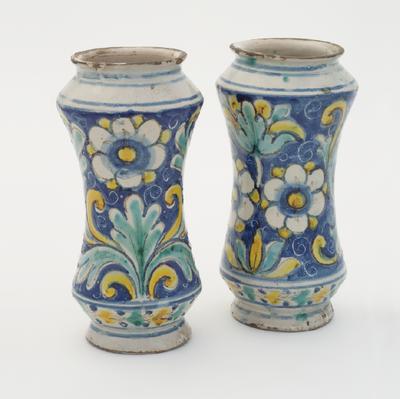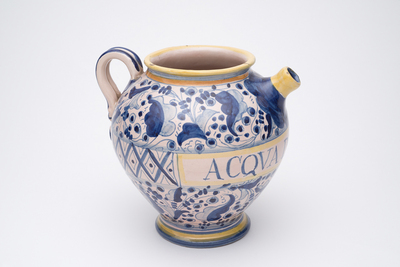Pair of majolica albarelli
Date
17th Century-18th Century
Description
Pair of Italian Majolica albarelli in grey ground with blue body decorated with stylised acanthus leaves, cartouches and florals in green and yellow.
This shape of jar was used as a storage vessel for solid materials kept by apothecaries.
The colourful maiolica of Italy flourished in the Renaissance. Its white tin glaze andnewly developed range of colours were used in a variety of regional styles, showing the vitality of the Renaissance artistic achievement in both stylised designs and figurative decoration. The technique was spread by Italian artisans and welcomed and naturalised throughout Europe as faience in France (from Faenza), and later as delftware. Sicily has a long tradition of glazed earthenware production, with important centres in Palermo, Trapani and Caltagirone. The city of Caltagirone flourished in the sixteenth and seventeenth centuries, when it had a fine hospital and a university which taught
medicine alongside law and philosophy. At its height there was a population of about 20 000 and it has been estimated 1000 people were employed in its potteries.Though Caltagirone declined because of a famine in 1671 and was then destroyed by earthquake in 1693, it remains well-known for its ceramics. The albarello (the etymology of the term is disputed) is a shape which appears in much earlier storage jars from Syria and elsewhere in the Arab world, whence also
came most of the apothecary’s exotic drugs before the discovery of new sources in the Americas. It was used as a storage vessel for the solid materials kept by the apothecary,alongside spouted pots for syrups, wooden boxes and glass vessels, sometimes wrapped in straw to prevent breakage, in the manner of the traditional chianti bottle. The tall,waisted form provided a secure grip for the apothecary dispensing its contents. These two jars would have been part of a set lined up on open shelving to make a fine display. The exuberant design is influenced by the style of Venetian pharmacy jars from the sixteenth-century workshop of Domenego da Venezia. (There are several in the museum
at Messina, Sicily, one signed and dated 1562.) These bold florals were imitated also by potters who supplied the important centre of medical learning at Montpellier in France.
Margaret Legge
See full details
Object detail
23.0 x11.5 cm (MHM2009.36.2)



Do you know something about this object?
Be the first to comment on this object record.